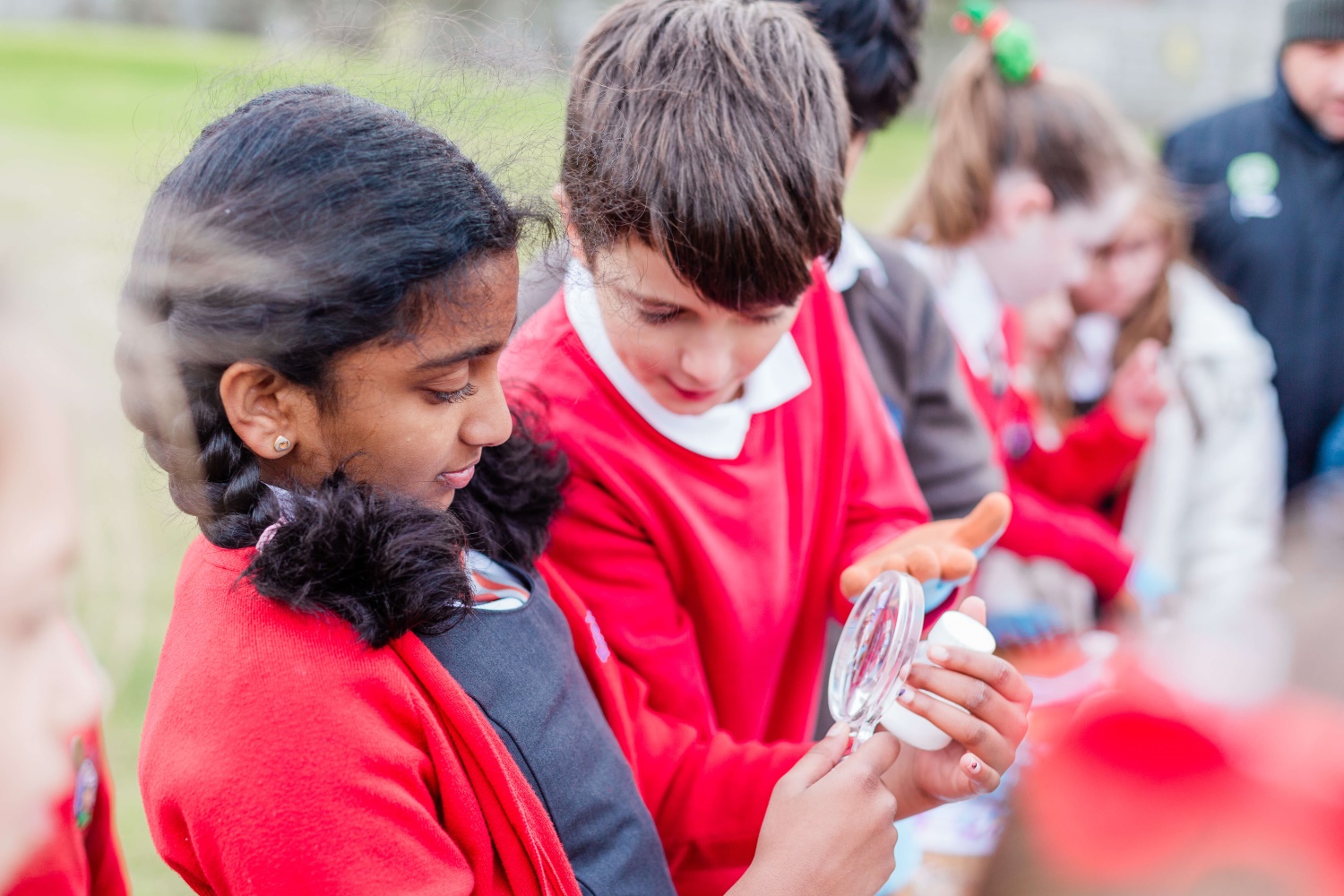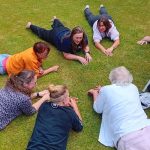Attainment: The impacts of outdoor learning and play
Discover how outdoor learning and play can improve pupil attainment, and what we’re doing to help schools harness the benefits of the outdoor classroom.
Earlier this year, Learning through Landscapes celebrated its 35th anniversary, marking over three and a half decades supporting schools and early years settings to make the most of their outdoor spaces. Outdoor learning and play enrich the curriculum, foster a deeper connection to nature, and promote good health and wellbeing for all learners, which is why we’re working to make outdoor learning and play part of every school day, ensuring that more children can enjoy the benefits.
For many children, most of the time they spend outside is comprised of the time they spend learning and playing in the school grounds, making it even more important to get pupils into the outdoor classroom whenever possible. However, for teachers, we know that concerns about meeting curriculum demands present one of the biggest barriers to taking classes outdoors.
Children, parents, and school staff alike are all feeling the exam pressure. Accordingly, many busy educators fear that too much time outdoors during the school day robs from valuable teaching time. Yet, we know that time spent learning and playing outdoors is often the most valuable teaching time, capable of boosting attainment and supporting curriculum aims even outside of lessons.
In the previous posts in this series, we explored the impacts of outdoor learning and play for promoting wellbeing and encouraging climate action. In this final instalment, we’re looking at how learning and playing outdoors improve attainment, why it’s increasingly important for educators to harness the benefits of the outdoor classroom, and what we’re doing to support this at Learning through Landscapes.
Building skills to cement learning for life
The best learners are healthy, happy learners. From the outset, outdoor learning and play offer enormous benefits for physical and mental wellbeing, which translate to improved performance inside the classroom. When we asked why educators choose to teach outdoors, they universally told us that their pupils were better behaved and more engaged learners during and after outdoor lessons. Even letting off some steam at break time can offer benefits back in the classroom!
However, it’s important to remember that play is learning, too — and not only for young children. Playing outdoors at all stages of school presents invaluable opportunities for children to develop key skills — communication, teamwork, creativity, problem solving — setting them up for success across the curriculum and into their adult lives.
In 2024, we became the guardians of Outdoor Classroom Day, the global campaign to celebrate outdoor learning and play. Having been involved since its inception, we were proud to bring our 35 years of knowledge and expertise to the campaign which is, at its heart, simply about helping more children and young people to enjoy the benefits of time outdoors. Whether it’s a game of tag in the school grounds, an adventure activity during a residential trip, reading a book in the garden, or simply enjoying a quiet moment in nature, the benefits derived from any time outdoors make it worthwhile. So, where does outdoor learning fit into the picture?
Supporting curriculum aims in the outdoor classroom
When they hear the words “outdoor learning”, many people think of extra-curricular programmes like Forest School, built to develop confidence and self-esteem through regular sessions in a natural setting. Such programmes offer inspiring and valuable experiences, but they are not the only way for children to learn outdoors. At its heart, outdoor learning is just a way of teaching — which means it’s easy to integrate into the curriculum.
Increasingly, governments are recognising the immense value of outdoor learning and play for young minds. In Wales, making the most of the outdoor environment for delivering effective education is strongly encouraged in the curriculum. In Scotland, it is an expectation for all children under Learning for Sustainability. In England, the National Education Nature Park, commissioned by the Department for Education, aims to embed nature-based learning in the curriculum while encouraging children to take action to improve their site for wildlife, and we are delighted to lead its delivery across early years settings.
Since 1990, we’ve worked tirelessly to support educators in taking the curriculum outdoors, providing resources, training, and funding to develop their skills and confidence, and championing the importance of future-proof school grounds for outdoor learning and play. We know that teachers come up against numerous obstacles to taking lessons outdoors, which is why Alex Bingham-Wallis develops our free outdoor lesson ideas with those obstacles in mind:
They’re simple activities that can be implemented with ease, making them a great tool for busy teachers. The cross-curricular aspect of many of the activities means that teachers can adapt the lesson to achieve a range of outcomes and suits the needs of the class. They’re designed to be as straightforward as possible, helping to build confidence in taking curriculum learning outdoors and highlighting how accessible it can be.
— Alex Bingham-Wallis, Training and Development Officer
As Alex suggests, reaping the benefits of taking lessons into the outdoor classroom doesn’t have to be difficult, even at secondary school. Importantly, it doesn’t have to involve extra work either. As our CEO, Matt Robinson, says, “We’re asking for different, not more.”
Reducing the barriers to taking lessons outdoors
In 2022, we published Teaching the Primary Curriculum Outdoors, a manual full of hands-on ways to build outdoor learning into the primary school curriculum in a way that brings joy to pupils and teachers alike. Mary Jackson, who was heavily involved with the creation of the book, said:
We specifically looked at all four UK curricula and designed activities that work for them, from maths and literacy to science and music. Some ideas are warm-up activities while others require a quick visit outside to collect resources before bringing them back into the classroom. Some are quick, some take a full lesson. Certain activities include an overall theme that can be delivered across many subject areas, several are subject specific. But the underlying thread is always the same: to help teachers deliver the curriculum.
— Mary Jackson, Head of Education and Communities
By providing educators with the tools they need to ease into teaching outdoors, we hope to help even more children enjoy the benefits of outdoor learning and play. Importantly, for those who struggle in a traditional classroom environment, the outdoor classroom can offer additional benefits when it comes to attainment specifically.
Outdoor learning is inclusive learning
From literacy to numeracy to STEM, taking topics from across the curriculum out into the school grounds offers hands-on, practical, experiential learning that working in schoolbooks cannot. Outdoor learning can help to bring difficult concepts to life, making them easier to understand. This is especially important when teaching about climate change, biodiversity, and sustainability, where connecting with the natural world they’re learning about can have a huge impact on children’s engagement with the subject matter.
However, taking learning into a different context — such that many pupils forget that it’s learning at all — is particularly helpful for children who lack confidence in the classroom. When we asked why educators choose to teach outdoors, one teacher told us, “They’re less afraid to ask questions away from a classroom environment. Being outdoors makes it ‘real world’.” Another said:
They don’t see outdoor lessons as lessons, so they seem to learn more and demonstrate their abilities better. They are less inhibited by their own beliefs that they ‘can’t read’ or ‘can’t do maths’ — they just learn!
— Jane, educator at a special school for children aged 4-19 in Leicester
Time and time again, we see that harnessing the power of the outdoor classroom can make learning more inclusive and reach those children who don’t respond well to more traditional teaching methods. Importantly, teachers themselves can benefit from the shift in environment, too — on both a personal and professional level.
Boosting teacher confidence in the school grounds
The wellbeing boost provided by spending time outdoors during the school day applies to children and adults alike. Just like the best learners are healthy, happy learners, the best teachers are healthy, happy teachers! However, many educators aren’t enjoying the benefits of teaching outdoors as often as they could, citing everything from a lack of outside space to poor weather as barriers.
The truth is, all the reasons educators give for avoiding the outdoor classroom ultimately boil down to one thing: a lack of teacher confidence. That’s why so much of our work at Learning through Landscapes focuses on helping teachers to build the confidence they need through outdoor learning and play training, showing school staff exactly how easy it is to take learning into the school grounds — and even how to improve them where necessary.
Through the Local School Nature Grants project, we’ve provided thousands of schools across England, Scotland, and Wales with specialist training across a range of outdoor learning topics, supporting them in taking that crucial first step outdoors. Cindy Grant observes that:
You always know an outdoor workshop is going well when staff start planning tomorrow’s outdoor maths or poetry lesson. When you take them outdoors and invite them to try out some lesson activities, they are often surprised at how much curriculum learning can be done with very few resources and the possibilities suddenly open up. I find that staff start discussing the practicalities in a really positive way, sharing ideas with each other and coming up with creative ways to make it happen. Hands-on training outdoors is a real motivator!
— Cindy Grant, Training and Development Officer
Explore more benefits of outdoor learning and play
Whether it’s improving attainment by enriching the curriculum, encouraging climate action by fostering a deeper connection to nature, or promoting good health and wellbeing for staff and pupils alike, the benefits of outdoor learning and play are clear — and they’re becoming increasingly important with every year that passes.
The charity continues to grow and adapt to our ever changing world. However, after 35 years of Learning through Landscapes, one thing remains true: the best place for children to learn is still outdoors. That’s why we’ll continue to support schools and early years settings in making outdoor learning and play part of every school day, ensuring that more children can enjoy the many benefits.
Sign up to our newsletter to stay up to date with the latest outdoor learning news and opportunities, or follow us on Bluesky, Facebook, and Instagram.












